Year (So Far) In Review: Micheal Ferland’s Difficult Debut

On July 10, 2019, more than a week after the Free Agent Frenzy had subsided, the Vancouver Canucks made one more addition to their roster – signing Micheal Ferland to a four-year contract with an annual cap hit of $3.5 million.
Proponents of the move argued that Ferland had signed at a discount far below his estimated market value, and that his rare combination of scoring prowess and physicality made his salary a bargain.
Critics argued that adding another middle-six winger to the mix was superfluous and that Ferland’s history of concussions made any long-term contract a risky endeavour.
Now, a year later, it looks as if each side of the debate had a valid point to make.
Injuries Aside, How Did Ferland Perform?
At first blush, Micheal Ferland’s first season with the Canucks does not look like it was a successful one. With just one goal and five points across 14 games, Ferland was on pace for less than 30 points even if he did play a full season – which he did not. In fact, Ferland’s point-scoring pace was his lowest since his sophomore season with the Calgary Flames, and his goal-scoring pace was the worst of his career.

From NHL.com
Fortunately, there’s plenty of statistical evidence to suggest that Ferland’s middling statline was more the result of an early-season production slump than a true reflection of his talents.
First and foremost, it should be noted that the final three of his 14 games played, or nearly a quarter of his season, were complete write-offs.
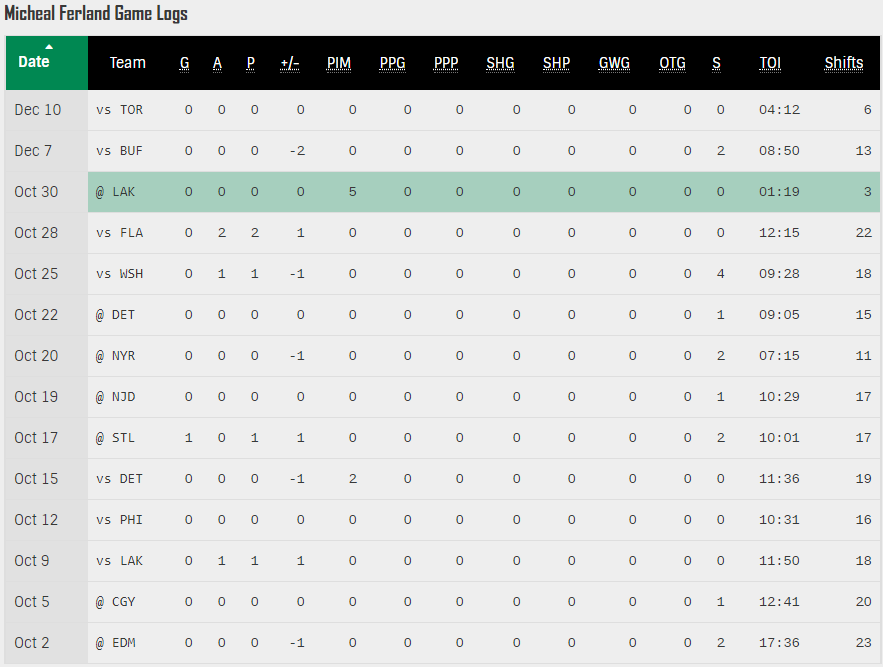
From NHL.com
On October 30, 2019, Ferland only played 1:19 before fighting Kyle Clifford and sustaining the head injury that would plague him for the rest of the season. He returned for two games in December, but was still very much in the throes of post-concussion-related symptoms at the time, and played fewer than 20 shifts between the two games before going on the LTIR again.
When he was healthy, Ferland was scoring on only 6.7% of his shots, below his career shooting percentage of 10.4%, which is usually the trademark of a player experiencing bad puck-luck – though it should be noted that this is also too small of a sample size to draw any conclusions from.

From Hockey-Reference.com
Speaking of sample sizes, it’s probably time to talk about Ferland’s overall advanced statline – which wasn’t exactly encouraging. Ferland sits at or near the bottom of almost every single notable category, including Corsi, Expected Goals For, and Scoring Chances.
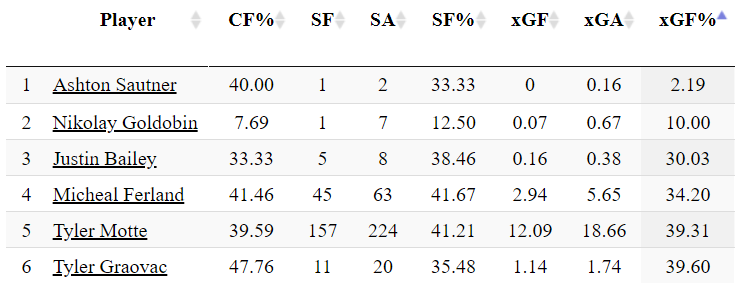
From NaturalStatTrick.com
His Corsi percentage relative to the rest of his teammates was an abysmal -13.8%, tied with Jay Beagle for second-worst on the entire roster and ahead of only Nikolay Goldobin and his ignominious eight minutes of ice-time. That’s not very good company to keep.
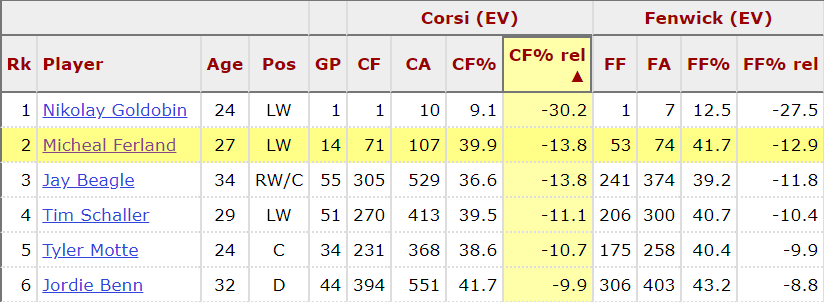
From Hockey-Reference.com
The real root of Ferland’s limited production, however, seems to be his limited deployment. Even during his first 11 healthy games of the season, coach Travis Green only played Ferland for an average of about 11 minutes per game – far less ice-time than Ferland received while scoring at a 20-goal pace for the Flames and Hurricanes in the two seasons prior.
In fact, Ferland’s points-per-60-minutes rate of 2.2 is right in line with his rate of production in both 2017/18 and 2018/19, which might lead some to conclude that he would have scored at the same pace in Vancouver if he had received the same amount of ice-time. Ferland’s points-per-60-minutes also ranked tenth on the team overall.

Instead, Ferland’s minutes only decreased throughout October, and he received fewer offensive zone starts and significantly less powerplay time than he had with his previous teams. He was also slotted all over the lineup, never landing on a consistent line for more than a game or two at a time.
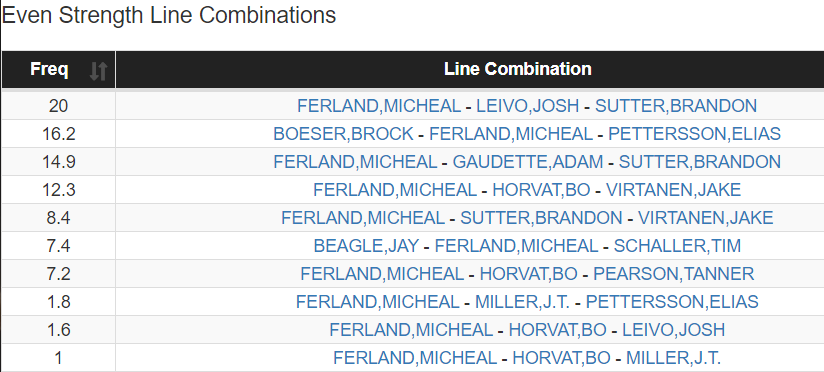
From Dobber’s Frozen Tools
Defensive shortcomings might explain Ferland’s reduced minutes, but that does not seem to be the case based on what is, admittedly, a very small sample size put together by HockeyViz.

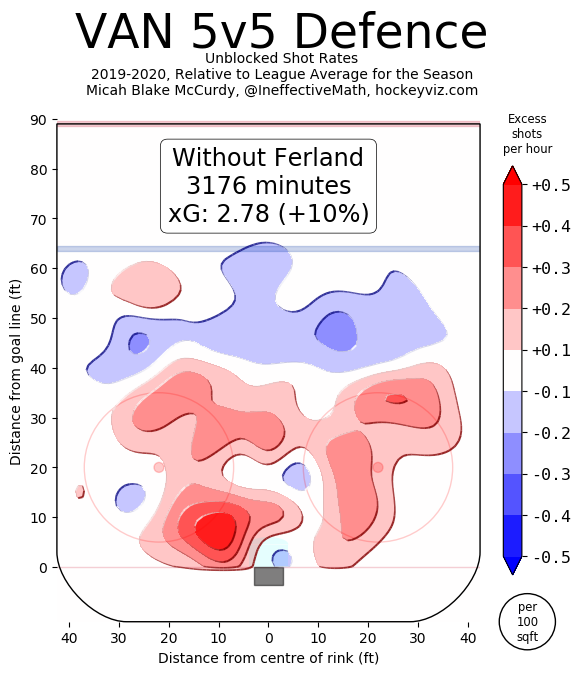
From HockeyViz.com
All of which supports the assertion that Ferland’s performance was better than his raw numbers would indicate.
However, it also supports the notion that Ferland was a superfluous addition from the get-go, which we’re going to talk about in the next section.
The Roster Fit And Intangible Contributions
Ultimately, Micheal Ferland’s lack of ice-time can be primarily attributed to the fact that coach Travis Green simply had better options in his arsenal – but is that something that the Canucks should have anticipated before offering Ferland a contract?
At the time of his signing, Vancouver had at least three clear-cut top-six wingers on the roster in JT Miller, Brock Boeser, and Tanner Pearson. A host of others – including Jake Virtanen, Josh Leivo, Sven Baertschi, Nikolay Goldobin, Antoine Roussel, and Zack MacEwen – were in the mix for the remaining “middle-six” slots.
That might seem like an abundance of talent now, and more than enough to render Ferland redundant, but there was still plenty of uncertainty heading into the season.
Sure, the breakouts of Virtanen, Leivo, and MacEwen – along with the acquisition of Tyler Toffoli and the pending arrival of Nils Hoglander – have conspired to shuffle Ferland down to the bottom of the depth chart, but none of those things was a guarantee to occur.
Ferland provided insurance in case any of those other options faltered – though, in the end, it was Ferland who faltered and those other options who filled in for him.
He was also meant to provide mentorship and a positive role model for some of those younger wingers, as GM Jim Benning outlined in the offseason.
Such intangibles are, by their very nature, impossible to measure, but it is still important to note that Ferland brings more to the table than just offence and defence.
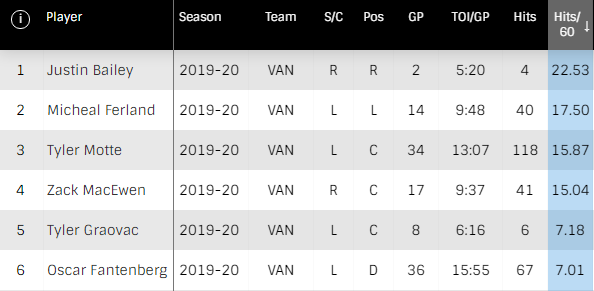
From NHL.com
He was second on the team in hits-per-60-minutes with a staggering 17.50, including some truly memorable bashes.
It is as of yet unknown just how much physicality Ferland will be able to keep in his game whenever he returns to play – but it is safe to say that it will still be more than the average NHL player provides.
Was It Worth The Risk?
There are certain questions that we’re not going to attempt to answer in this article.
The question of Micheal Ferland’s continued health, and whether or not it will be safe for him to return to NHL play is the business of Ferland and the medical professionals he consults with entirely. Speculating on it would be both fruitless and inappropriate.
The risk that Ferland would take on by returning to the Canucks next season – or this season, if the league does find a way to complete 2019/20 – is something that should be assessed by Ferland and his family alone, without input from fans, the media, or anyone else with an opinion.
It is, however, still fair game to discuss whether or not the risk taken by the Canucks in signing Ferland was truly worth it, all things considered.
In terms of production and fit within the roster, the answer looks like it might be “no” – though only with the benefit of hindsight and the emergence of a much cheaper option in Zack MacEwen.
Ferland’s injury concerns are a bit of a wash in this regard – insurance covers the cost of his salary if he remains on LTIR and his cap hit can be replaced – and it remains to be seen how well he might perform if totally healthy for an extended period.
The real risk moving forward, however, comes if Ferland is healthy enough to safely return to playing in the NHL – but only in a diminished capacity. If Ferland proves to be only capable of putting up similar numbers to what he has thus far in Vancouver for the foreseeable future, then that’s an awful lot of cap space tied up in a redundant player.
The best that the Canucks fanbase can hope for is a complete and total return to health for Ferland, and for that to come with the return of his scoring prowess. Anything less will leave the franchise in an awkward position moving forward.
Recent articles from Stephan Roget




